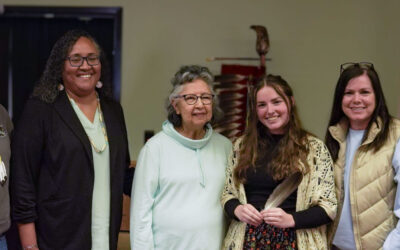Written by Behavioral Health Consultant Angie Gingrich
The year 2020 has been challenging. In March 2020, the entire world started on a journey that was unprecedented, unexpected, and has worn us all out. COVID-19 has created havoc on people’s physical health, but also, there is much concern for the collective toll it has taken on our emotional health. The heightened stress, uncertainty, and isolation that began last spring have created something called COVID fatigue. We are all experiencing this fatigue in some way. It is described by Ohio State University researchers as “a phenomenon that has occurred as the body attempts to adapt to feeling overwhelmed and stressed.” Our bodies are designed to go into “fight or flight” mode when faced with an emergency, but what happens when that emergency lasts for eight months and there is no end in sight? Our bodies and minds get tired of being in constant crises which puts us at risk for experiencing mental health issues. This challenge has been growing since March but is particularly concerning as winter approaches.
Winter is often a challenging time from a mental health viewpoint for a number of reasons. The first and most obvious may be that it’s dark. We wake up in the dark, we leave work in the dark, and the dark is not good for our mood. There is a name for depression related to lack of sunlight. SAD, or Seasonal Affective Disorder, usually begins in the fall and lasts through spring.
Seasonal Affective Disorder occurs in approximately 4-6% of the population every year.
American Association of Family Physicians
On top of COVID fatigue and SAD, another trigger for winter depression is the holiday season. According to the Andy Williams Christmas song “It’s the most wonderful time of the year.” Unfortunately, there are a significant number of people for whom the opposite is true. The holidays can be very painful when you are inundated with messages telling you that you are supposed to be happy, to be spending time with loved ones, to have the time, energy, and money to make everything just right for a perfect season, when you can’t. This could be the case any year, but particularly in 2020 as people everywhere are trying to navigate how to honor traditions and stay safe, how to celebrate when they may have lost family members to COVID or may be facing financial challenges which are new and different.
These three factors put all Americans at risk. According to the American Medical Association, one in ten Americans experience depression in any given year. Native Americans report the highest rates of any ethnic group at 19%. In light of these numbers, it is crucial that attention be paid to our mental health this winter. A proactive approach is best and includes working actively to prevent depression, being mindful to watch for signs and symptoms, and knowing what to do to get help.
The following are all suggestions for prevention:
Use what works for you and skip over those that don’t. Each person is different and will respond to different approaches.
- Be mindful of your body. There is a strong connection between physical and mental health. Stay hydrated, get good rest, and eat a healthy diet.
- Foster connectedness. COVID has made this harder, but seek out safe ways to avoid isolation. Find an exercise buddy who is respectful of masks/social distance and walk six feet apart. Set up zoom meetings with family or friends. Use apps such as Marco Polo to send short video clips back and forth. Everyone needs human connection and we need to work to maintain it right now.
- Laugh. Research shows that laughter is therapeutic. It releases endorphins and puts us in a positive mindset. Watch funny movies or videos, read funny stories, look for things in everyday life to make you laugh. If you aren’t finding anything funny, force yourself to laugh anyway. There are many tutorials on laughter therapy on YouTube, find them, and use them.
- Stay active. Weather allowing, get outside during those precious daylight hours if at all possible. There is nothing like movement and the sun on your skin to keep your spirits lifted.
- Use a therapy lamp. These lamps are designed to make up for lack of sunlight in winter. Sitting in front of them each morning helps to increase the production of Vitamin D and lift the mood. They are available on Amazon and are quite affordable.
- Utilize mindfulness skills. This could be in the form of meditation practice, yoga, bilateral stimulation, or journaling among others. These are all ways to process troublesome thoughts and maintain a healthy, calm mind. There are apps and YouTube videos that can provide guidance on each of these. A few helpful ones are listed at the end of this article.
- Pay attention to your mood. Take a moment each day to notice how you are feeling. Document or use an app such as Moodflow to track this in order to look for patterns which can be helpful to help identify what needs to change if you do fall into depression.
- Find an activity or project you are passionate about that you can work on over winter. This could be organizing photos, learning a new skill, planning a future event among other things.
Despite the best efforts to avoid depression, it sometimes still occurs. If you experience a combination of the following symptoms, it would be a good idea to seek help.
- Sleep disturbances, either sleeping too much or too little.
- Changes in appetite: being unable to eat anything or overeating, a craving for sweet or starchy foods
- Weight gain
- A heavy feeling in the arms or legs
- A drop in energy level
- Fatigue
- Difficulty concentrating
- Irritability
- Increased sensitivity to social rejection
- Avoidance of social situations — not wanting to go out
Help is available through NHBP, or can be arranged with outside providers if preferred. This can be on a short-term or long-term basis, and can also be a one-time consultation to evaluate options and provide feedback. NHBP medical staff are available to discuss medication options if desired. The behavioral health team is available if ongoing counseling is desired or for shorter problem-solving interventions. Both teams are available for telehealth sessions, medical is available in-person if desired and all conversations are confidential. There are other options available for people not comfortable utilizing Tribal resources. Most employers offer Employee Assistance Plans which could provide help.
For those who are not employed or who do not have an EAP, call 211 to discuss help available in your area.
Please see below for links to informative websites:
- https://www.mayoclinic.org/diseases-conditions/seasonal-affective-disorder/symptoms-causes/syc-20364651
- https://youtu.be/iGGJrqscvtU
- https://www.psychologytoday.com/us/blog/the-crime-and-justice-doctor/202008/crisis-fatigue-and-the-covid-19-pandemic
- https://www.amitahealth.org/blog-articles/behavioral-health/covid-fatigue-and-how-to-fight-it
- https://www.nami.org/mhstats




0 Comments